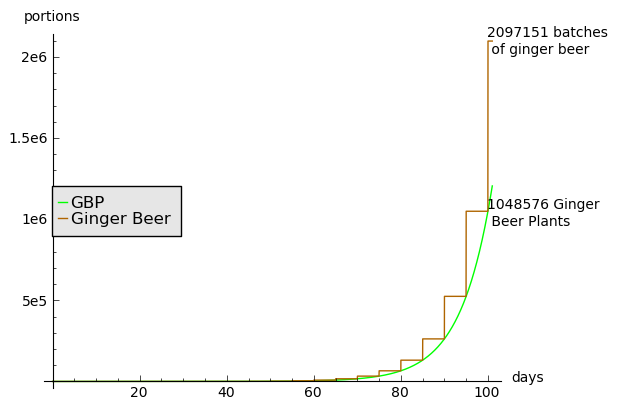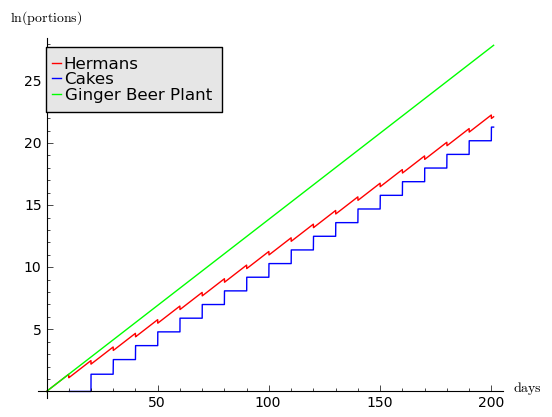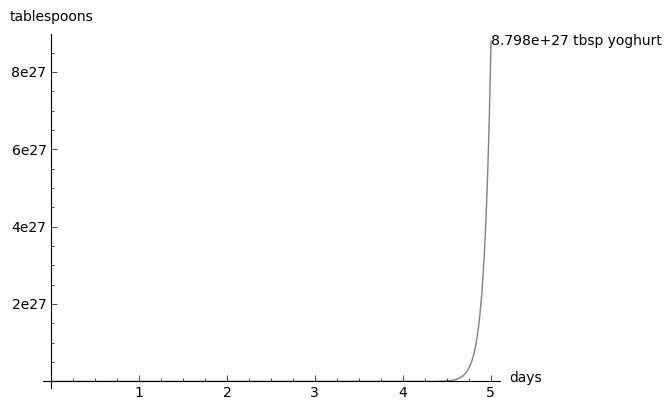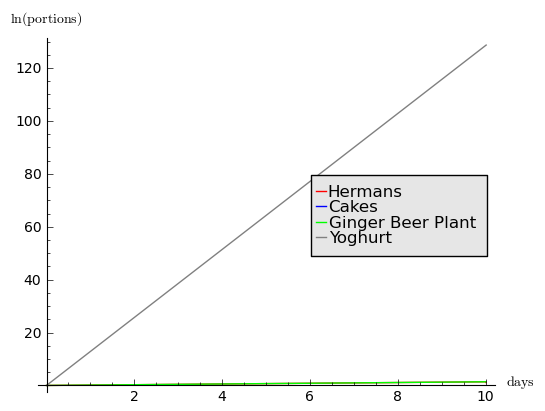I recently heard about Herman, the German Friendship Cake (bear with me), a cake which is divided and spread among friends, and it got me thinking about some other foodstuffs I’ve heard of which are made in such a way that the amount you have will grow exponentially. A Herman cake is a special type of sourdough cake which is made with yeast. It’s explained fully here, but the idea is that you start with a solution of yeast, which lives in a little milk, sugar and flour. This small amount of goo can live happily at room temperature on a shelf, and if you stir it every day and give it a little more flour and sugar to eat every few days, after ten days it’s ready to make into a cake.
At this point you add more sugar, milk and flour, and divide the resulting mixture into four parts. Each of these will be identical to the original mixture you started with. One quarter of the mixture gets added to a cake recipe, consisting of more flour, sugar and milk as well as chunks of apple and raisins, which you bake into a lovely sourdough cake. The other three parts, you pass on to friends, who can then leave them on the shelf for ten days as you did, until they’re ready to split and make into cakes. This means that starting with one cup of yeast mixture, every ten days you get one cake and three new cups of yeast mixture.
The Herman itself (the yeasty goop) triples in quantity every ten days, and produces cake at an appropriately increasing rate (the number of cakes after each ten-day period increases by the number of cups of Herman which existed ten days previously). The graph below shows the growth of each up to 100 days, at which point you have $59\!,\!049 = 3^{10}$ Hermans and $29\!,\!423 = \sum_{i=1}^{10} 3^{i-1}$ cakes.
Yes, you do have to add other ingredients to get it to be cake, and yes, you could just make a cake for yourself without passing any goop on to any of your friends, but it’s a nice idea and I imagine it’s fun to be part of the chain. Pyramid schemes get my approval if and only if they involve cake.
Another substance which I’m told multiplies unstoppably is ginger beer. The basis of home-made ginger beer is an object known as a GBP, or Ginger Beer Plant, which isn’t a plant but a clump of yeast and bacteria. A tablespoon-sized piece of this gets put in a container with a grated hunk of ginger, some water and sugar, and left to ferment for five days. You can then take out the GBP, add lemon juice and cream of tartar, and drink the resulting 2 litres of ginger beer (which everyone on the internet is adamant is much nicer than shop bought ginger beer). The plant doubles in size during this time, so that you can then split it into two and use both parts to make another batch. This results in a growth factor per day of $1.149 \approx \root 5 \of 2$, compared with $1.116 \approx \root 10 \of 3$ for the Herman. (By growth factor I mean the amount you’ll have on a given day relative to the amount you had yesterday.)
Here’s a comparison of Hermans and Ginger Beer Plants:
However, the most impressive self-replicating foodstuff I’ve found is yoghurt. I’ve always found it amusing that one of the ingredients of homemade yoghurt is yoghurt – but it makes sense, as it’s essentially milk which has been thickened using a bacterial culture, and the easiest place to find a sample of that culture is in live yoghurt. Much of the yoghurt sold in shops is deactivated (which means the bacteria is dead), but if you know where to look you can purchase yoghurt which still contains live bacteria. You can take two to three tablespoons of yoghurt, add it to half a gallon of milk, and apply controlled amounts of heat to produce basically half a gallon of yoghurt. It’s left to culture for around seven hours. For your first home-made batch, you have to buy in some live yoghurt, but beyond this you can happily use the last few tablespoons of your previous batch.
This means that every two to three tablespoons of yoghurt can be used to make a further half gallon of yoghurt. That’s around 128 tablespoons! This means each unit of yoghurt creates around $43 \approx \frac{128}{3}$ times as much yoghurt every seven hours, and such a theoretical 24-hour yoghurt-making enterprise would blow both ginger beer and Herman cake out of the metaphorical water with a growth factor per day of around $388,000$. Given the right strains of bacteria, this process can be repeated indefinitely. Next time you tuck into a yoghurt, just think of how quickly yoghurt could take over the earth, given enough milk.
And here’s another comparison in logs, this time including the yoghurt:
If you know of any other foodstuffs which grow exponentially in this way, especially if they can beat the impressive growth rate of yoghurt, then please let me know in the comments below. And before you ask, I don’t want in to your friendship cake pyramid.
You can see Christian’s working out, for the awesome graphs accompanying this post, in this Sage Notebook.





As a committed foodie who, at various points in my life, has made ginger beer, sourdough bread and hundred of litres of raw milk yoghurt I absolutely love this post ;)))
Kombucha works pretty much the same as ginger beer, except that it looks awful.